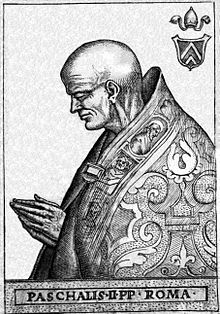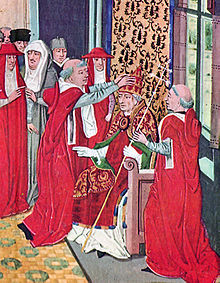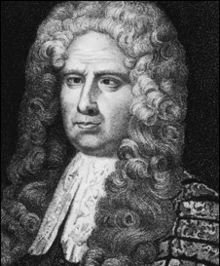1000s

The following elections occurred between the years 1001 and 1700.




Pope Gregory X, born Teobaldo Visconti, was head of the Catholic Church and ruler of the Papal States from 1 September 1271 to his death and was a member of the Secular Franciscan Order. He was elected at the conclusion of a papal election that ran from 1268 to 1271, the longest papal election in the history of the Catholic Church.
The dean of the College of Cardinals presides over the College of Cardinals in the Roman Catholic Church, serving as primus inter pares. The position was established in the early 12th century. He always holds the rank of a cardinal bishop, and is assisted by a vice-dean. Both are elected by and from the cardinal bishops who are not Eastern Catholic patriarchs, with their election subject to papal confirmation. Except for presiding over the college, the dean and vice-dean have no power over the other cardinals. In the order of precedence in the Catholic Church, the dean and vice-dean, as the two most senior cardinals, are placed second and third, respectively, after the pope.
Papal coats of arms are the personal coat of arms of popes of the Catholic Church. These have been a tradition since the Late Middle Ages, and has displayed his own, initially that of his family, and thus not unique to himself alone, but in some cases composed by him with symbols referring to his past or his aspirations. This personal coat of arms coexists with that of the Holy See.

The Roman Catholic Suburbicarian Diocese of Ostia is an ecclesiastical territory located within the Metropolitan City of Rome in Italy. It is one of the seven suburbicarian dioceses. The incumbent Bishop is cardinal Giovanni Battista Re. Since 1150, its bishop has been the Dean of the College of Cardinals, Its Cathedral is Basilica di Sant'Aurea.

The Renaissance Papacy was a period of papal history between the Western Schism and the Reformation. From the election of Pope Martin V of the Council of Constance in 1417 to the Reformation in the 16th century, Western Christianity was largely free from schism as well as significant disputed papal claimants. There were many important divisions over the direction of the religion, but these were resolved through the then-settled procedures of the papal conclave.

The Roman Catholic Suburbicarian Diocese of Palestrina is a Roman Catholic suburbicarian diocese centered on the comune of Palestrina in Italy.
The Roman Catholic Suburbicarian Diocese of Velletri–Segni is one of the suburbicarian dioceses, Catholic dioceses in Italy close to Rome with a special status and a cardinal bishop, the bishop of Velletri–Segni. Historically, the see of Velletri was combined with the see of Ostia from 1060 to 1914.
The table of years in art is a tabular display of all years in art, for overview and quick navigation to any year.

A cardinal-nephew was a cardinal elevated by a pope who was that cardinal's relative. The practice of creating cardinal-nephews originated in the Middle Ages, and reached its apex during the 16th and 17th centuries. The last cardinal-nephew was named in 1689 and the practice was abolished in 1692. The word nepotism originally referred specifically to this practice, when it appeared in the English language about 1669. From the middle of the Avignon Papacy (1309–1377) until Pope Innocent XII's anti-nepotism bull, Romanum decet pontificem (1692), a pope without a cardinal-nephew was the exception to the rule. Every Renaissance pope who created cardinals appointed a relative to the College of Cardinals, and the nephew was the most common choice, although one of Alexander VI's creations was his own son.

A crown-cardinal was a cardinal protector of a Roman Catholic nation, nominated or funded by a Catholic monarch to serve as their representative within the College of Cardinals and, on occasion, to exercise the right claimed by some monarchs to veto a candidate for election to the papacy. More generally, the term may refer to any cardinal significant as a secular statesman or elevated at the request of a monarch.
Ubi periculum is a papal bull promulgated by Pope Gregory X during the Second Council of Lyon on 7 July 1274 that established the papal conclave format as the method for selecting a pope, specifically the confinement and isolation of the cardinals in conditions designed to speed them to reach a broad consensus. Its title, as is traditional for such documents, is taken from the opening words of the original Latin text, Ubi periculum maius intenditur, 'Where greater danger lies'. Its adoption was supported by the hundreds of bishops at that council over the objections of the cardinals. The regulations were formulated in response to the tactics used against the cardinals by the magistrates of Viterbo during the protracted papal election of 1268–1271, which took almost three years to elect Gregory X. In requiring that the cardinals meet in isolation, Gregory was not innovating but implementing a practice that the cardinals had either adopted on their own initiative or had forced upon them by civil authorities. After later popes suspended the rules of Ubi periculum and several were elected in traditional elections rather than conclaves, Pope Boniface VIII incorporated Ubi periculum into canon law in 1298.

Perugia was a long-time papal residence during the 13th century. Five popes were elected here: Pope Honorius III (1216–1227), Pope Clement IV (1265–1268), Pope Honorius IV (1285–1287), Pope Celestine V (1294), and Pope Clement V (1305–1314). These elections took place in the Palazzo delle Canoniche adjoining the Perugia Cathedral.